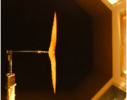 Robotic aircraft of the future, used for reconnaissance or communication, may need to rely on wing morphing, a trick mastered ages ago by birds for long flights. By measuring how ultraversatile swifts morph their wings to double their gliding time or triple their turn rate, researchers have given both biologists and engineers a greater understanding of the secrets of efficient flight.
Robotic aircraft of the future, used for reconnaissance or communication, may need to rely on wing morphing, a trick mastered ages ago by birds for long flights. By measuring how ultraversatile swifts morph their wings to double their gliding time or triple their turn rate, researchers have given both biologists and engineers a greater understanding of the secrets of efficient flight.
Swifts dramatically change wing shape depending on their needs. When the birds dart after insects, they sweep their wings back up to 50 degrees, reducing their head-on profile. They also glide so efficiently that they can sleep aloft, with their wings spread straight out. But studies of live birds run into problems because birds only employ the most efficient form of flight, making it difficult to compare, for example, how a straight wing performs at both low and high gliding speeds.
So graduate student David Lentink of Wageningen University in the Netherlands tested hand-positioned swift wings in a wind tunnel. By measuring the drag and lift on the wings (removed from dead birds) over a range of different angles and airspeeds, Lentink and colleagues created a model for predicting the best wing shape for each type of maneuver. They predicted that swifts’ most efficient glide would occur with straight wings at 8-10 meters per second. Radar observations of sleeping swifts confirm that this is the case. The experiment also measured the astonishing benefits of morphing wings: Swifts can double their gliding time or triple their turn rate by morphing their wings. “Of course we already knew that birds change their wing shape during flight, but nobody actually measured the benefits quantitatively before,” says Lentink, who reports the findings in tomorrow’s issue of Nature.
“A lot of people have suggested why birds should sweep their wings at different angles,” says biomechanics researcher David Alexander at the University of Kansas in Lawrence, “but as far as I know this is the first quantitative test.” The results should also have aeronautical applications because DARPA and other cutting edge aerospace researchers have been interested in morphing wings for decades, he says.
And biologists shouldn’t feel left out by all the engineering applications, either, according to biomechanics researcher Adam Summers at the University of California, Irvine. “This has potential for comparative biomechanics,” he says. “I think we’ll learn some wonderful things about the evolution of flight.”
This story first appeared on ScienceNOW: [html] [pdf]